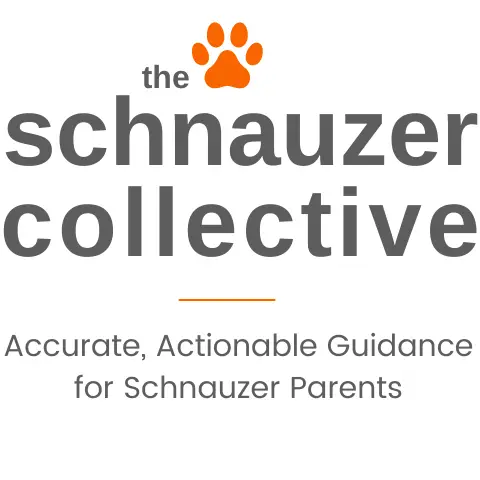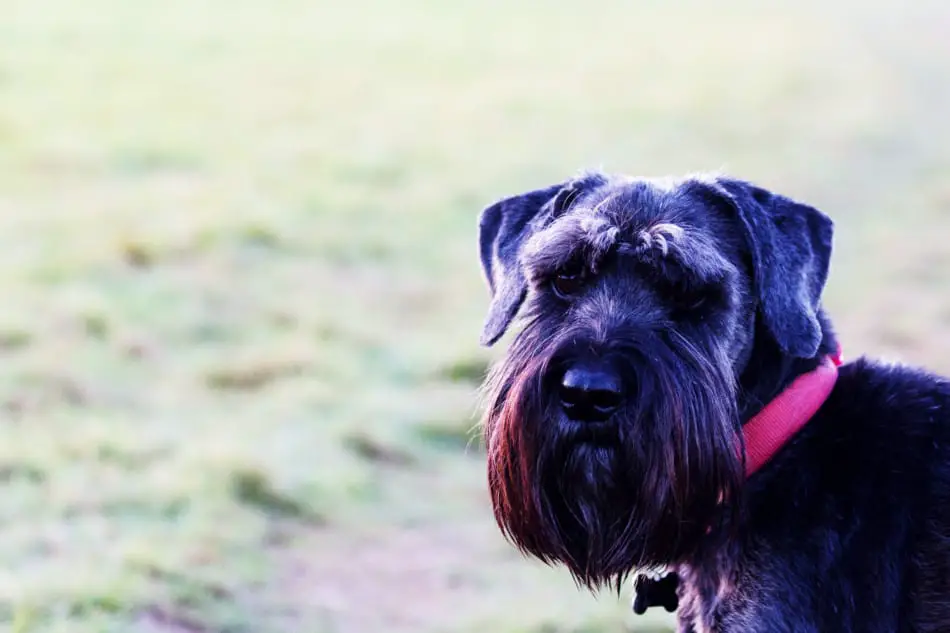Our neighbors have a Giant Schnauzer and although he is still technically a puppy, I am struck by how…well…giant he is. Like nearly all Giant Schnauzers, he is solid black and carries off the traditional bearded Schnauzer look with elegance and ease. However, (and especially because I was attacked by a large dog when I was young), he looks a little threatening and frightening. The truth is, he is fun-loving and gentle. In his case, the primary thing that makes him at all threatening is his sheer size. What makes him safe is his temperament and that he is well-trained and well-socialized. But what about Giant Schnauzers in general? Are they dangerous and aggressive? Here’s what you should know.
Giant Schnauzers are not bred to be dangerous or overly aggressive, but they are very large and have historically been guard dogs and herders. They are naturally territorial and protective of their home environments and human families. Strong training and socialization are essential, but they can be fun, safe dogs.
The Giant Schnauzer is an excellent companion for dog owners who love big dogs.
Specially bred for guarding and herding, they have transitioned easily into police and guard work. Giant Schnauzers are intelligent, confident, and may become headstrong if not trained or socialized early on.
However, a well-trained Giant Schnauzer is polite to strangers, playful and loving, but remains protective to his immediate family. Of course, each individual Giant Schnauzer will have his own temperament due, in part, to both his parentage and current environment.
Let’s talk more in-depth about the Giant Schnauzer’s general temperament and whether they are potentially dangerous and aggressive.
Are Giant Schnauzers Dangerous and Aggressive?
Unfortunately, the answer is not a simple “yes” or “no.”
To round out a full and helpful answer, we’ll need to take a look at several aspects of their size, breeding, temperament, territorial aggression, and training needs.
Giant Schnauzer Size


- Height: 23-28 inches
- Weight: 65-110 pounds
- Lifespan: 10-12 years
- Food: 4-5 cups each day, spread over two or more small meals
- Intelligence: Ranked in the top 35 of 140 dogs
- Popularity: Ranked 80th out of 190 dogs
Giant Schnauzers have a massive body build, are courageous, and extremely loyal.
Male Giant Schnauzers can weigh up to 110 pounds, and their sheer size and muscular, bearded frame can make them look intimidating. His body structure gives many people the impression that he is hot-tempered or extremely aggressive, which is not generally the case. Giant Schnauzers are often only aggressive and dominant towards dogs of the same sex and strangers, and they exhibit their territorial nature by barking which we’ll cover below.
The primary thing to keep in mind is that even gentle Giant Schnauzers can be dangerous to small pets, small children, and seniors simply because of their enormous size and weight.
Breeding
Giant Schnauzers were originally bred to guard German farms and drive livestock, hence their territorial nature. As mentioned above, they were also used as military and police dogs, which is a role they still play today.
While Giant Schnauzers are generally loving and friendly dogs, their guard dog breeding and instincts simultaneously (and ironically) can make them suspicious of human strangers and other animals.
It’s this mix of breeding purposes that have led to an overall strong, but gentle temperament mixed with some territorial tendencies.
Let’s take a look at both of them.
Temperament
As with all dogs, each Giant Schnauzer will inherit temperament traits from his particular lineage. He will also develop his own personality within a general temperament. Well-trained and well-socialized Giant Schnauzers are generally confident, playful, protective companions.
However, even within those general tendencies, you may also see some noticeable differences.
For example, some Giants will be headstrong and confident while others might be sweet and mellow. This range of traits are all possible within Giant Schnauzers who are trained and socialized early, often, and well.
Even with excellent training and broad socialization that exposes a Giant Schnauzer to a variety of experiences, animals, and people, he will still need to manage his genetic and in-bred tendency to some amount of territorial aggression.
Let’s talk honestly about what territorial aggression can look like in Giant Schnauzers and if it makes them dangerous.
“Well-trained and well-socialized Giant Schnauzers are generally confident, playful, protective companions.”
THE SCHNAUZER COLLECTIVE
Territorial Aggression
Territorial aggression occurs when something different about sound, sight, or action triggers an anxious, alerting, or defensive response. This behavior is often exhibited toward other dogs or people approaching the Schnauzer’s home or family.
Since Giant Schnauzers are predisposed to guard their owners, they can exhibit territorial aggression to intruders. Most forms of aggression occur at their home, but they may also exhibit some territorial behavior at parks, picnic areas, and walking paths.
The most common form of territorial aggression involves barking and growling.
If your Schnauzer is not trained and socialized, then snapping, biting, chasing, and lunging are all possibilities.
In addition, restraining your Schnauzer from gaining access to what is bothering him may actually heighten hostility, develop redirected behavior, or cause him to exhibit displacement behaviors such as circling, spinning, or self-mutilation.
Your Schnauzer is likely to continue the aggressive behavior unless he is well-trained and socialized early, preferably within his first six months of life. Early and consistent training and socialization will help him to distinguish between safe situations and threatening situations.
Most Schnauzer’s aggressive behavior is caused by instinct, not imminent danger. As such, you need to make it difficult to engage in aggressive behavior so that it doesn’t become an unproductive habit.
While Schnauzer hostility and aggression is relatively rare, their in-bred territorial nature should be harnessed through training.
Six Keys to Controlling a Schnauzer’s Territorial Aggression

Whether you have a new Giant Schnauzer puppy or need to re-train a more mature Giant, these tips will give you a starting point.
Be sure to involve a professional trainer if you need support or if you know that you need better training skills to manage your Giant Schnauzer, especially since his sheer size is a factor.
Key #1: Early Socialization
Early socialization is critical to prevent territorial aggression. Young Schnauzers can be taught to sit and remain calm when a stranger comes to visit. You can reduce their fear and anxiety towards visitors by welcoming many visitors to your home when the puppy is still young.
All Giant Schnauzers absolutely need very early outings to dog parks, neighborhood walks, puppy play dates, and other social gatherings.
Help your Giant get a sense for what normal, safe social relationships are like in your day-to-day life. This will help him distinguish better between what he does and does not need to be territorial about.
Key #2: Obedience Training
Giant Schnauzers are an intelligent breed. Add that intelligence to some amount of stubbornness, a territorial nature, and massive size, and you have a dog breed that needs a firm training hand. While training doesn’t need to be (and in my opinion, shouldn’t be) harsh, it does need to be structured and consistent.
Again, if you are new to training dogs you may want to work with a professional dog trainer.
Your Giant Schnauzer needs to know who is in charge. If it’s not you, then it will be your Schnauzer (guaranteed).
Here are a few obedience training tips to help you:
- Establish Your Leadership: Establish yourself as a leader to ensure he is obedient to your commands. Apart from watching over livestock and homes, Schnauzers would hunt in packs. As such, they were loyal to the pack leader, waiting for directions on how and where to hunt. You need to establish your position because he is looking to you for direction.
- Establish an outcome: Decide how you want to train your dog. Do you want to attend a dog training program at a nearby club or train him at home? Think about the outcome and how you want to achieve it. Beginning with professional puppy training can give you the basic skills you need for success.
- Keep up with his learning ability: We’ve already established that Schnauzers are intelligent. They are able to learn quickly and, more importantly, they are always learning. Your Schnauzer will watch you and learn from everything you do.
Key #3: Exercise His Brain
While obedience training goes a long way in controlling territorial aggression, mental stimulation is just as important. When his brain is exhausted he is less likely to engage in destructive behavior. Trick training is an excellent mind-engaging activity. You can also introduce dog sports like flyball or cart pulling. Interactive games and treat puzzles can be good indoor options.
Key #4: Reward Good Behavior
A Schnauzer’s territorial nature can make him somewhat reactive. Training him to control his urges and shape his behavior will come through consistency and firmness, but also through rewards.
Start with the basics by teaching him to look at you, then to sit and stay. Reward all successful attempts with a treat and praise.
Additional practice should help him know when to stay when there is a distraction outside and when to react. Be sure to keep the training interesting while rewarding him.
Key #5: Positive over Negative
Practical training involves rewarding and praising behavior you would want to see again. Modern dog training has come to emphasize positive reinforcements over punishments. Yelling, punishing, and other negative forms of shaping his behavior only serves to either increase aggression or develop a traumatized dog.
Key #6: Make Changes to the Environment
If your Giant has a particular spot where he waits on visitors to start barking at them, consider making some changes. Move the sofa, his favorite hangout spot, or block access to the room. If his favorite barking spot is outside, consider blocking his vision, bringing him inside, or simply restricting access to specific portions of the yard.
Now that we’ve covered some key aspects of a Giant Schnauzer’s temperament and the potential for some amount of territorial aggression if he is not well-trained or socialized, you may be wondering if a Giant Schnauzer is worth the work.
I thought it might be helpful to cover some of the honest pros and cons of taking care of a Giant Schnauzer…all from actual owners’ perspectives.
Are Giant Schnauzers Hard to Take Care Of?
Giant Schnauzers can be a challenging yet rewarding breed for pet parents who are willing to invest the time.
Overall, Giant Schnauzer owners will tell you that they are a phenomenal breed and well worth the effort, but lets’ take a look at some of the reported pros and cons.
Giant Schnauzer Pros

Intelligent
The Giant Schnauzer is extremely intelligent, which makes it easy to train, especially if you are firm and consistent. He was originally bred as an all-round dog to help on the farm with herding, carting, and to protect humans and his territory. Today, dog owners don’t have hay bales to cart or livestock to herd hence the need to look for activities that keep the Giant Schnauzer busy. Allow him to help you find objects, carry things, and pick up things.
Responsible and Reliable
His intelligence and level of energy make the Giant Schnauzer reliable and successful in different fields, including military and police work, dog sports, guide, and rescue work. It explains its tremendous success in obedience trials, agility, carting, herding, and lure coursing.
Protective
The Giant Schnauzer is primarily a guard dog hence protects its subjects fiercely. He is also intensely loyal and is instinctively territorial. This personality makes him somewhat unfriendly to strangers. However, since he is a fast learner, it is possible to teach him to welcome visitors.
While his size might not make him ideal for very small children or seniors, a Giant Schnauzer can make a terrific family dog and, when well-trained and socialized, will be a loving addition.
Ideal for People with Allergies
The Giant Schnauzer has a strong wiry coat that does not shed. This makes him ideal for people with allergic reactions and those looking for dogs that don’t shed. However, the coat needs regular trimming and clipping (usually after every two months).
Giant Schnauzer Cons

High Maintenance Grooming
Grooming a Giant Schnauzer requires a significant time investment. While they are hypoallergenic and don’t shed much, the trade-off is that you will need to brush his coat and beard to avoid matting.
The coat needs to be brushed 3-4 times a week using a stiff-bristled brush to avoid or remove mats and tangles. Some owners prefer taking their Giant to a professional groomer since the coat needs regular trimming and clipping (after every 4-6 months)
Like all Schnauzers, the Giant Schnauzer has two coats: the outer coat is hard, wiry, dense and waterproof while the undercoat is soft and silky. Regular grooming helps maintain the quality and texture of the coating, which improves its utilitarian purpose. It is important to start grooming him as a puppy so that he becomes accustomed to a routine.
There’s always the debate about whether to hand-strip or the clip the coat. Breed purists believe that the wiry coat should not be clipped because it strips off the wiry nature of the outer coat. Instead, they advocate for hand-stripping, which is often time-consuming and uncomfortable for the dog. Unless your Giant Schnauzer is a competitive show dog, the choice will be yours.
Needs A Lot of Exercise
The Giant Schnauzer has a large body build hence needs a great deal of exercise. Two long daily walks or 30-60 minutes of rigorous training in the back yard should keep him mentally and physically active. Hiking is also a great option. Truthfully, some Giants might need up to 2 hours of exercise each day.
Lack of exercise causes him to invent his own games in a bid to display his frustration and boredom. He is likely to chase the kids around, run around with his toys, and generally wreak havoc in the house.
Needs Firm Respect Training and Socialization
As we’ve already addressed as the focus of this article, and an appropriate place to end, the Giant Schnauzer was originally bred as a watchdog and can be potentially aggressive to you and other dogs if not trained and socialized adequately.
His level of intelligence enables him to quickly learn how to avoid obeying or complying with your commands. He is particularly selective about who he obeys, only listening to whom he considers the dominant family member.
Respect training is particularly important as it allows him to learn about the positive and negative consequences of their behavior and establish your position as the pack leader. Being a pack leader does not mean being a bully; instead, you enforce control and dominance toward him without being harsh. It is a combined effort of sound leadership and training a Giant to earn his treat. This way, he will learn to complete obedience commands before getting anything.
You also don’t want him to pull the leash. If you allow him to take the lead, he will control all other aspects of life. Let him walk beside or behind you. During walks, make frequent stops, and give obedience commands. Respect training does not stop; it is part of a Giant Schnauzer’s daily routine.
Your Giant should be able to trust you to lead, protect, and direct them throughout their life. It is essential to build a strong bond with him before training. When Giant Schnauzers feel secure with the people around them, they are likely to respond better to training commands.
Giving clear rules, boundaries, limitations, and conditioning good behavior should help cultivate trust between you and your Giant. Be sure to designate a special place for training where you will not be distracted by other pets or children.
While Giant Schnauzers require effort and commitment, with the proper training and socialization, he can become an ideal protector and companion, providing a larger-than-life yet gentle presence.
They are not bred to be either dangerous or overly aggressive, however territorial aggression made worse by a lack of training and socialization is possible.
Early, effective, and consistent training and socialization makes all the difference.
And finally, from one pet parent to another, discover my all-time favorite resources designed to cover your every Schnauzer need. I’ve done the legwork for you so you can spend more time with the people and fur friends in your life.
A portion of all profit earned on this site is donated to Pet Partners
whose mission is to improve human health and
well-being through the human-animal bond.
They train and register pets to become therapy animals,
and have local chapters in many states.

